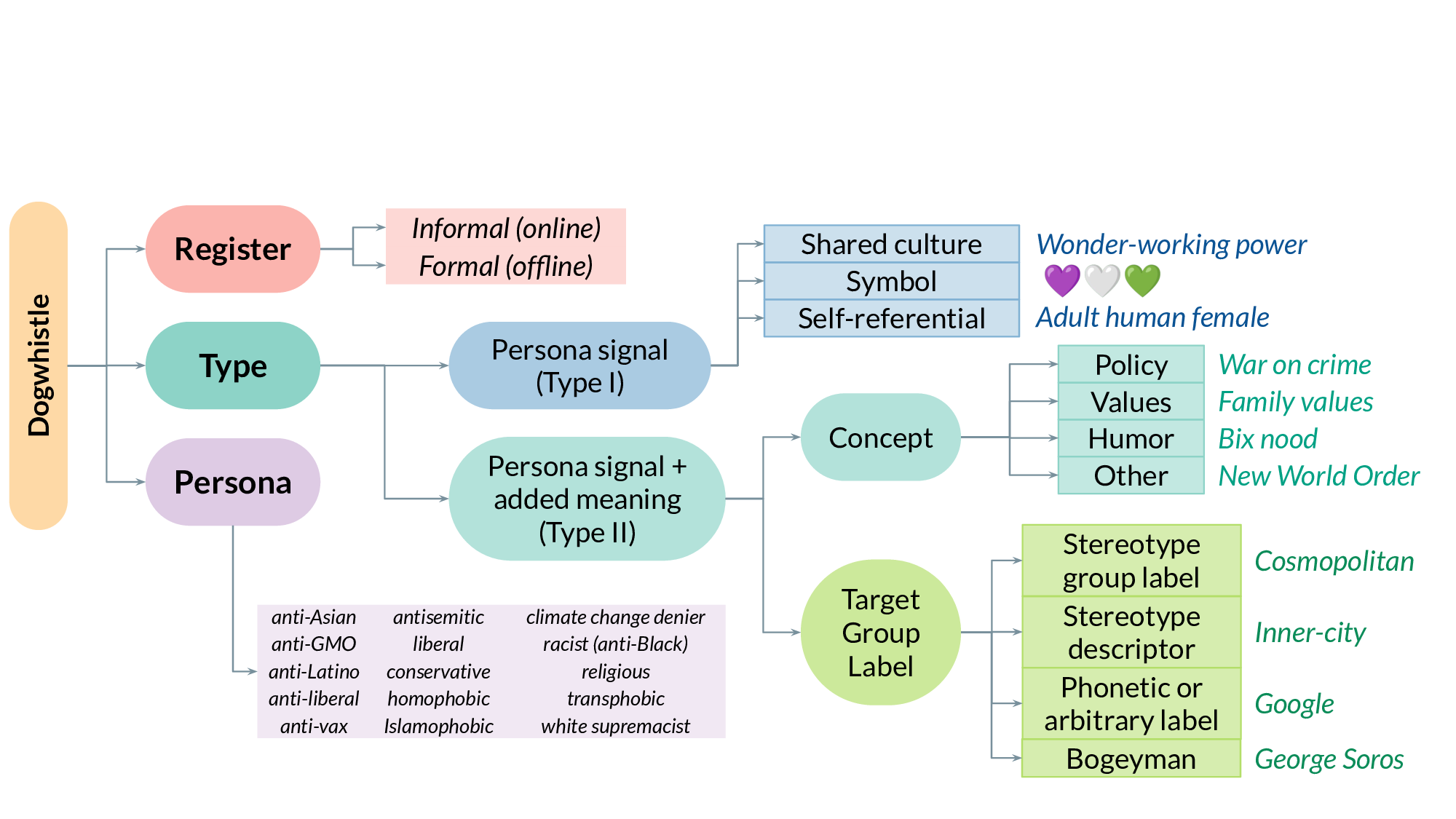
From Dogwhistles to Bullhorns
Unveiling Coded Rhetoric with Language Models
Dogwhistles are coded expressions that simultaneously convey one meaning to a broad audience and a second one, often hateful or provocative, to a narrow in-group.
In this work, we conduct the first large-scale computational investigation of dogwhistles. We develop a typology of dogwhistles, curate the largest-to-date glossary of over 300 dogwhistles with rich contextual information and examples, and analyze their usage in historical U.S. politicians’ speeches. We then assess whether a large language model (GPT-3) can identify dogwhistles and their meanings, and find that GPT-3's performance varies widely across types of dogwhistles and targeted groups. Finally, we show that harmful content containing dogwhistles avoids toxicity detection, highlighting online risks of such coded language. This work sheds light on the theoretical and applied importance of dogwhistles in both NLP and computational social science, and provides resources for future research in modeling dogwhistles and mitigating their online harms.
How do dogwhistles work?
Here is a schematic of how dogwhistles work, based on Henderson and McCready (2018), using as example the dogwhistle Cosmopolitan.

First, a speaker simultaneously communicates the dogwhistle message and their per- sona (identity). The in-group recovers both the message content and speaker persona, enabling them to arrive at the coded meaning (e.g. Jewish). The out-group only recognizes the message’s content and thus interprets it literally. This literal meaning also provides the speaker with plausible deniability; if confronted, the speaker can claim that they solely intended the literal meaning.
Taxonomy of dogwhistles
Based on prior work and our own investigations, we craft a new taxonomy of dogwhistles (see figure below) and categorize them by register, type, and persona.

Register
We label all dogwhistles as either part of a formal/offline or informal/online register. Formal/offline dogwhistles originated in offline contexts or are likely to appear in statements by mainstream political elites (e.g. family values). The informal/online register includes dogwhistles that originated on the internet and are unlikely to be used in political speech (e.g. cuckservative).
Type
Following Henderson and McCready (2018), Type I dogwhistles covertly signal the speaker’s persona but do not alter the implicatures of the message itself, while Type II dogwhistles additionally alter the message’s implied meaning. We extend this typology to highlight the wide variety of dogwhistles. We identify three subcategories of Type I-dogwhistles: symbols (including emojis, abbreviations, and imagery), self-referential terms for members of the in-group, and dogwhistles that require specialized knowledge from a shared in-group culture. Type II dogwhistles tend to fall into two subcategories: they name a concept or serve as a substitute for a target group label. We further divide concepts into policies (titles for initiatives with covert implications, such as law and order), values that the in-group purports to uphold, expressions whose covert meanings are grounded in in-group humor, and other concepts, which are often coded names for entities that are not group labels (e.g. the New World Order conspiracy theory is antisemitic but does not name or describe Jewish people).
Persona
Persona refers to the in-group identity signalled by the dogwhistle. This is an open class with many potential in-groups. There is considerable overlap in membership of listed in-groups, but we label persona based on what is most directly related to the dogwhistle.Glossary of dogwhistles
The glossary contains 340 English-language dogwhistles and over 1,000 surface forms (morphological variants and closely-related terms), mostly from the U.S. context. Each dogwhistle is labeled according to the taxonomy (i.e. its register, type, and signaled persona), an explanation from a linked source, and at least one example with linguistic, speaker, situational, and temporal context included, as well as a link to the example text. Antisemitic, transphobic, and racist (mostly anti-Black but sometimes generally against people of color) dogwhistles are the most common, with over 70 entries for each persona. The glossary includes dogwhistles with other personae, such as homophobic, anti-Latinx, Islamophobic, anti-vax, and religious.
See also: Glossary
To add a new entry to the glossary, please submit the following form: Dogwhistle Submission Form
About this work
This work was led by Julia Mendelsohn and advised by Ronan Le Bras, Yejin Choi, and Maarten Sap. For more information, please see the ACL'23 paper.
Citation: Julia Mendelsohn, Ronan Le Bras, Yejin Choi & Maarten Sap (2023). From Dogwhistles to Bullhorns: Unveiling Coded Rhetoric with Language Models. ACL
